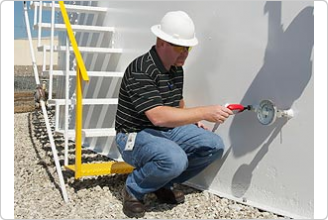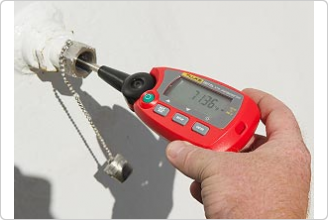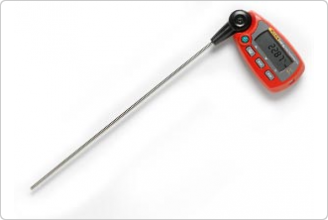- Other Fluke companies:
- Fluke
- Fluke Biomedical
- Fluke Networks
- Fluke Process Instruments
1551A Ex / 1552A Ex "Stik" Thermometer Readout

Finally, a digital substitute for your mercury-in-glass thermometers! Accurate and repeatable to ± 0.05 °C over its full range, the Fluke 1551A, Fluke 1552A “Stik Thermometer is the new “gold standard" of industrial temperature calibration. Whether working outdoors in environments where potentially explosive gases may be present or on the floor of a processing plant, the intrinsically-safe, battery operated, portable reference thermometer is designed to go where you work.
Features at a glance
- Accuracy of ± 0.05 °C (± 0.09 °F) over full range
- Intrinsically safe (conforms to ATEX requirements)
- Two models to choose from (-50 °C to 160 °C or -80 °C to 300 °C)
- User-configurable temperature Trend/Stability indicator
- Display temperature in °C or °F
- Optional data logging to internal memory
- 300-hour battery life
- Percent battery-life and low-battery indicator
- NVLAP-accredited, NIST-traceable calibration included
Thermometer probe and digital readout combined into one unit
The stainless steel probe and digital readout are fixed together and calibrated as a system. The accuracy specification is easy to understand since it includes all uncertainty components, including drift, for up to one year. The large backlit LCD display rotates 90° degrees making it easy to read from any angle. A user-configurable stability/trend indicator lets you know when your temperature is stable enough to record an accurate measurement. A user-settable auto-off function extends typical battery life to three hundred hours. A low-battery indicator and stop-measure function prevent erroneous measurements from being made due to low battery life. A simple three-point calibration function allows you to easily and accurately calibrate the “Stik" Thermometer. Data logging to internal memory of up to 10,000 time-stamped measurements is optionally available.
Why calibrate process temperature sensors?
Because temperature greatly effects the accuracy of a volumetric measurement, process manufacturers of chemical, pharmaceutical, food or petroleum products require accurate temperature measurements—especially for processes where quality or custody transfer are regulated by government agencies. Since all temperature sensors are subject to drift with time, regular calibration or verification against a reliable reference thermometer is required. Finding a reference thermometer that is accurate, repeatable and robust, however, can be challenging.
What’s wrong with my reference thermometer?
Industrial reference thermometers available on the market today, such as mercury-in-glass thermometers (or “ASTM thermometers") and portable electronic thermometers are useful, but both come with inherent problems. Although accurate and repeatable, mercury thermometers are fragile. The risk of a mercury spill poses potential hazards to the environment and to the health of personnel. Many of the United States and European Union countries have already banned their use in industrial applications. Some organizations have replaced their mercury thermometers with more durable portable electronic thermometers, only to discover that the RTD probes lack the repeatability and dependability required of a legitimate reference thermometer.
The best alternative to mercury thermometers
The Fluke 1551A and Fluke 1552A “Stik" Thermometers are accurate, stable and durable, making it the best alternative to mercury thermometers and existing electronic thermometers. The thin-film RTD sensor incorporates the same characteristics of other premium reference thermometers designed by Fluke Calibration, but it is more robust and less susceptible to drift. Accuracy and repeatability, however, are not sacrificed for improved durability.
Using a glass-stem mercury- or spirit-filled thermometer at different immersion depths, or at significantly different ambient temperatures from which it was calibrated, may require the application of emergent-stem corrections that can be tedious but necessary to calculate an accurate measurement. This isn’t required with the “Stik" Thermometer. The sensor of the 1551A Ex requires a minimum immersion depth of only seven centimeters (2.8 inches), with no appreciable effect on the measured temperature due to heat loss through stem conduction. Some digital thermometers can become less accurate when used outside a narrow range of ambient temperatures. This isn’t the case for the “Stik" Thermometer. Your measurement remains accurate in ambient temperatures from -10 degrees to 50 degrees celsius (14 degrees to 122 degrees fahrenheit). With a superior probe design combined with electronic functions that assist accurate measurement, the “Stik" Thermometer surpasses the capabilities of other digital thermometers and is the perfect substitute for your mercury thermometers. 1In order to minimize sensor drift, the probe should always be protected from mechanical shock.
Five reasons to replace mercury thermometers
- Since the “Stik" Thermometer does not contain mercury, it is not subject to government-imposed bans. Government agencies worldwide have either banned or are seeking to ban the use and transportation of industrial mercury thermometers—this seems to be a growing trend.
- The stainless steel probe sheath of the “Stik" Thermometer is far more robust than the glass stem of a mercury thermometer and better suited for industrial environments. And since the “Stik" thermometer does not contain mercury, the risk of an accidental mercury spill is eliminated.
- When considering cost of ownership, a digital thermometer is less expensive than a mercury thermometer. With a mercury thermometer, you either invest in equipment or you hire out to clean up after a mercury spill.
- Mercury thermometers cannot be adjusted after calibration. The actual temperature must be calculated by applying corrections to the measured temperature. This costs time and is susceptible to calculation error. A digital thermometer does the math for you—the displayed temperature accurately represents the actual measured temperature.
- Emergent-stem corrections may also be required if the mercury thermometer is not used under the same conditions under which it was calibrated. A digital thermometer doesn’t require that you match calibration conditions to achieve an accurate measurement. You’re only required to meet the minimum immersion requirements—which is only seven centimeters (2.8 inches) in the case of the 1551A Ex.
| Specifications | 1551A Ex | 1552A Ex |
| Measurement range | -50 °C to 160 °C | -80 °C to 300 °C |
| (-58 °F to 320 °F) | ( -112 °F to 572 °F) | |
| Accuracy (1 year) |
± 0.05 °C (± 0.09 °F) | |
| Resolution | Selectable: 0.1, 0.01, 0.001 (default 0.01) | |
| Sample rate | User selectable 0.5/sec, 1/sec or 2/sec Factory default is 1/sec |
|
| Readout temperature coefficient | Add ±10 ppm/°C of full scale temperature from −10 °C to 18 °C and 28 °C to 50 °C | |
| Probe temperature coefficient | 0.00385 Ω/Ω/°C nominal | |
| Nominal probe resistance at 0 °C |
100 Ω | |
| Probe hysteresis | ±0.01 °C | |
| Response time | Approximately 20 seconds | |
| Operating temperature range of readout | -10 °C to 50 °C (14 °F to 122 °F) | |
| Humidity range | 0 to 95 % RH Non-condensing | |
| Storage temperature range | -20 °C to 60 °C (-4 °F to 140 °F) | |
| Display units | °C, °F | |
| Sensor type | 100 Ω thin-film RTD | 100 Ω wire-wound PRT |
| Sensor length | ≤ 10 mm | ≤ 30 mm |
| Sensor position (from sheath tip) | 3 mm (0.1 in) | |
| Minimum immersion depth | Wet medium (liquid bath, thermowell with thermal compound) 70 mm (2.8 in) Dry medium (dry-well, thermowell without thermal compound) 120 mm (4.8 in) |
|
| Maximum immersion depth | 50 mm (2 in) less than the total length. Make sure the last 50 mm of probe, nearest to the internal electronics of the device, are not put into the heat source. | 75 mm (3 in) less than the total length. Make sure the last 75 mm of the probe, nearest to the internal electronics of the device, are not put into the heat source. |
| Probe sheath material | Stainless steel | |
| Optional data logging1 | Up to 10,000 time-stamped readings stored to internal memory | |
| Logging intervals1 | 2 seconds, 5 seconds, 10 seconds, 30 seconds, or 60 seconds | |
| Damping | Moving average of the most recent 2 to 10 readings (ON/OFF, 2, 5, 10) | |
| Communications | RS-232 stereo jack (access calibration parameters only) | |
| AC power | None | |
| DC power | 3-AAA alkaline batteries See Users Manual for approved batteries |
|
| Battery life | Approximately 300 hours (12.5 days) of continuous operation with the backlight off. | |
| Battery save (auto-off) range | Selectable from 1 to 30 minutes or can be disabled | |
| Safety | IEC 60079-0, IEC 60079-11: Ex ib IIB T4 Gb; IEC 61010-1: Pollution Degree 2 | |
| Electromagnetic compatibility |
International: IEC 61326-1: Portable Equipment; IEC 61326-2-2; CISPR 11: Group 1, Class B Group 1: Equipment has intentionally generated and/or uses conductively coupled radio frequency energy that is necessary for the internal function of the equipment itself. Class B: Equipment is suitable for use in domestic establishments and in establishments directly connected to a low voltage power supply network which supplies buildings used for domestic purposes. USA (FCC): 47 CFR 15 subpart B. This product is considered an exempt device per clause 15.103. |
|
| Size (readout only) | 125 mm x 62 mm x 35 mm (5 in x 2.5 in x 1.4 in) | |
| Probe size |
1551A-9: 4.8 mm x 229 mm (3/16 in x 9 in) 1551A-12: 6.35 mm x 305 mm (1/4 in x 12 in) 1551A-20: 6.35 mm x 508 mm (1/4 in x 20 in) 1552A-12: 6.35 mm x 305 mm (1/4 in x 12 in) |
|
| Weight | 200 g (6.9 oz) | |
| Calibration (included) | NVLAP-accredited, NIST-traceable | |
| Characterization | CVD | ITS-90 |
| 1See ordering information for optional data logging configurations | ||
| Model Name | Description |
|---|---|
| 1551A-9 |
1551A Ex Thermometer, Fixed RTD, -50 °C to 160 °C, 4.8 mm x 229 mm (3/16 in x 9 in) Includes NVLAP-accredited report of calibration, User’s Guide on CD-ROM, 3 AAA batteries |
| 1551A-12 |
1551A Ex Thermometer, Fixed RTD, –50 °C to 160 °C, 6.35 mm x 305 mm (1/4 in x 12 in) Includes NVLAP-accredited report of calibration, User’s Guide on CD-ROM, 3 AAA batteries |
| 1551A-20 |
1551A Ex Thermometer, Fixed RTD, -50 °C to 160 °C, 6.35 mm x 508 mm (1/4 in x 20 in) Includes NVLAP-accredited report of calibration, User’s Guide on CD-ROM, 3 AAA batteries |
| 1551A-9-DL |
1551A Ex Datalogging options Thermometer, Fixed RTD, -50 °C to 160 °C, 4.8 mm x 229 mm (3/16 in x 9 in) with Datalog Includes NVLAP-accredited report of calibration, User’s Guide on CD-ROM, 3 AAA batteries |
| 1551A-12-DL |
1551A Ex Datalogging options Thermometer, Fixed RTD, -50 °C to 160 °C, 6.35 mm x 305 mm (1/4 in x 12 in) with Datalog Includes NVLAP-accredited report of calibration, User’s Guide on CD-ROM, 3 AAA batteries |
| 1551A-20-DL |
1551A Ex Datalogging options Thermometer, Fixed RTD, –50 °C to 160 °C, 6.35 mm x 508 mm (1/4 in x 20 in) with Datalog Includes NVLAP-accredited report of calibration, User’s Guide on CD-ROM, 3 AAA batteries |
| 1552A-12 |
Thermometer, Fixed PRT, -80 °C to 300 °C, 6.35 mm x 305 mm (1/4 in x 12 in) Includes NVLAP-accredited report of calibration, User’s Guide on CD-ROM, 3 AAA batteries |
| 1552A-12-DL |
Thermometer, Fixed PRT, -80 °C to 300 °C, 6.35 mm x 305 mm (1/4 in x 12 in) with Datalog Includes NVLAP-accredited report of calibration, User’s Guide on CD-ROM, 3 AAA batteries |
Accessories common to all models:
| Application Notes |
|---|
| Data Sheets |
|---|
- Home
- Products
- New Products
- Electrical Calibration
- RF Calibration
- Data Acquisition and Test Equipment
- Temperature Calibration
- Humidity Calibration
- Pressure Calibration
- Flow Calibration
- Process Calibration Tools
- Calibration Software
- Service and Support
- All Calibration Instruments
- Purchase Info
- News
- Training and Events
- Literature and Education
- Service and Support
- About Us
Sidebar Request a Quote
Request a quote





